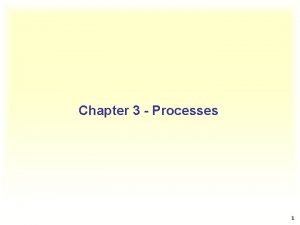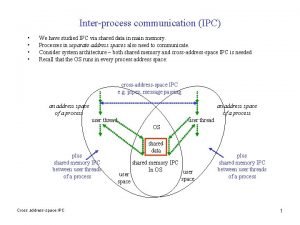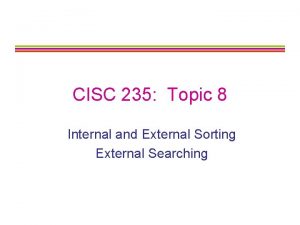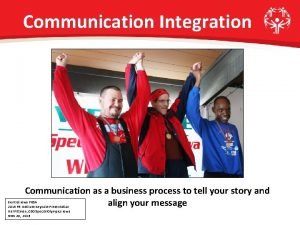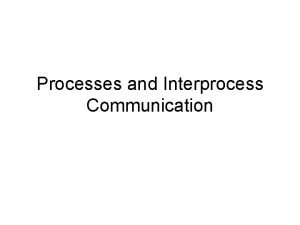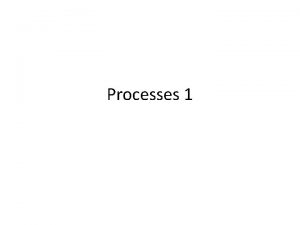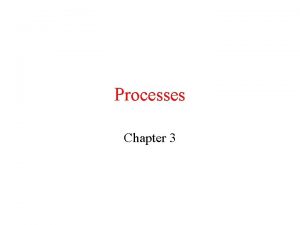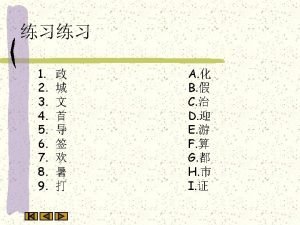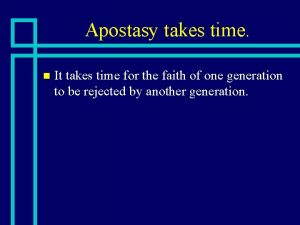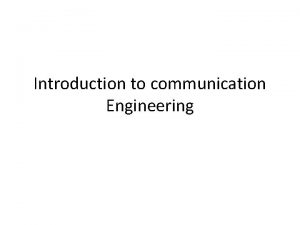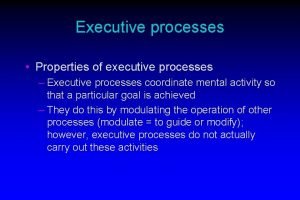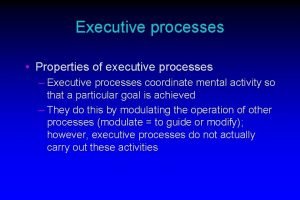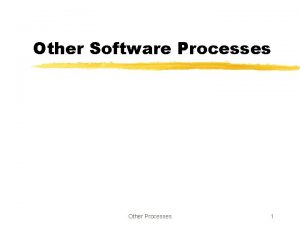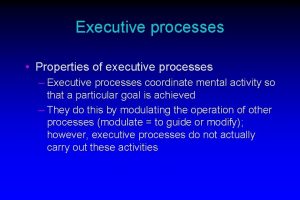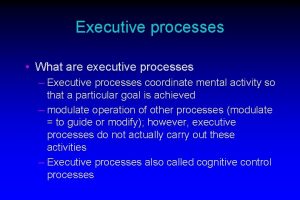Chapter 3 Processes 1 Introduction communication takes place

































- Slides: 33

Chapter 3 - Processes 1

Introduction § communication takes place between processes § a process is a program in execution § from OS perspective, management and scheduling of processes is important § other important issues arise in distributed systems § multithreading to enhance performance § how are clients and servers organized § process or code migration to achieve scalability and to dynamically configure clients and servers 2

3. 1 Threads and their Implementation § threads can be used in both distributed and nondistributed systems § Threads in Nondistributed Systems § a process has an address space (containing program text and data) and a single thread of control, as well as other resources such as open files, child processes, accounting information, etc. three processes each with one thread one process with three threads 3

§ each thread has its own program counter, registers, stack, and state; but all threads of a process share address space, global variables and other resources such as open files, etc. 4

§ § § Threads take turns in running Threads allow multiple executions to take place in the same process environment, called multithreading Thread Usage – Why do we need threads? § e. g. , a wordprocessor has different parts; parts for § interacting with the user § formatting the page as soon as changes are made § timed savings (for auto recovery) § spelling and grammar checking, etc. 1. Simplifying the programming model: since many activities are going on at once 2. They are easier to create and destroy than processes since they do not have any resources attached to them 3. Performance improves by overlapping activities if there is too much I/O; i. e. , to avoid blocking when waiting for input or doing calculations, say in a spreadsheet 4. Real parallelism is possible in a multiprocessor system 5

§ having finer granularity in terms of multiple threads per process rather than processes provides better performance and makes it easier to build distributed applications § in nondistributed systems, threads can be used with shared data instead of processes to avoid context switching overhead in interprocess communication (IPC) context switching as the result of IPC 6

§ Thread Implementation § threads are usually provided in the form of a thread package § the package contains operations to create and destroy a thread, operations on synchronization variables such as mutexes and condition variables § two approaches of constructing a thread package a. construct a thread library that is executed entirely in user mode (the OS is not aware of threads) § cheap to create and destroy threads; just allocate and free memory § context switching can be done using few instructions; store and reload only CPU register values § disadv: invocation of a blocking system call will block the entire process to which the thread belongs and all other threads in that process b. implement them in the OS’s kernel § let the kernel be aware of threads and schedule them § expensive for thread operations such as creation and deletion since each requires a system call 7

§ solution: use a hybrid form of user-level and kernel-level threads, called lightweight process (LWP) § a LWP runs in the context of a single (heavy-weight) process, and there can be several LWPs per process § the system also offers a user-level thread package for some operations such as creating and destroying threads, for thread synchronization (mutexes and condition variables) § the thread package can be shared by multiple LWPs combining kernel-level lightweight processes and user-level threads 8

§ Threads in Distributed Systems § Multithreaded Clients § consider a Web browser; fetching different parts of a page can be implemented as a separate thread, each opening its own TCP/IP connection to the server or to separate and replicated servers § each can display the results as it gets its part of the page § Multithreaded Servers § servers can be constructed in three ways a. single-threaded process § it gets a request, examines it, carries it out to completion before getting the next request § the server is idle while waiting for disk read, i. e. , system calls are blocking 9

b. threads § threads are more important for implementing servers § e. g. , a file server § the dispatcher threads incoming requests for a file operation from clients and passes it to an idle worker thread § the worker thread performs a blocking disk read; in which case another thread may continue, say the dispatcher or another worker thread a multithreaded server organized in a dispatcher/worker model 10

c. finite-state machine § if threads are not available § it gets a request, examines it, tries to fulfill the request from cache, else sends a request to the file system; but instead of blocking it records the state of the current request and proceeds to the next request § Summary Model Characteristics Single-threaded process No parallelism, blocking system calls Threads Parallelism, blocking system calls (thread only) Finite-state machine Parallelism, nonblocking system calls three ways to construct a server 11

3. 2 Anatomy of Clients § Two issues: user interfaces and client-side software for distribution transparency a. User Interfaces § to create a convenient environment for the interaction of a human user and a remote server; e. g. mobile phones with simple displays and a set of keys § GUIs are most commonly used § The X Window System (or simply X) § it has the X kernel: the part of the OS that controls the terminal (monitor, keyboard, pointing device like a mouse) and is hardware dependent § contains all terminal-specific device drivers through the library called xlib 12

the basic organization of the X Window System 13

b. Client-Side Software for Distribution Transparency § in addition to the user interface, parts of the processing and data level in a client-server application are executed at the client side § an example is embedded client software for ATMs, cash registers, etc. § moreover, client software can also include components to achieve distribution transparency § e. g. , replication transparency § assume a distributed system with replicated servers; the client proxy can send requests to each replica and a client side software can transparently collect all responses and passes a single return value to the client application 14

transparent replication of a server using a client-side solution § access transparency and failure transparency can also be achieved using client-side software 15

3. 3 Servers and design issues 3. 3. 1 General Design Issues § How to organize servers? § Where do clients contact a server? § Whether and how a server can be interrupted § Whether or not the server is stateless a. Wow to organize servers? § Iterative server § the server itself handles the request and returns the result § Concurrent server § it passes a request to a separate process or thread and waits for the next incoming request; e. g. , a multithreaded server; or by forking a new process as is done in Unix 16

b. Where do clients contact a server? § using endpoints or ports at the machine where the server is running where each server listens to a specific endpoint § how do clients know the endpoint of a service? § globally assign endpoints for well-known services; e. g. FTP is on TCP port 21, HTTP is on TCP port 80 § for services that do not require preassigned endpoints, it can be dynamically assigned by the local OS § IANA (Internet Assigned Numbers Authority) Ranges § IANA divided the port numbers into three ranges § Well-known ports: assigned and controlled by IANA for standard services, e. g. , DNS uses port 53 17

§ Registered ports: are not assigned and controlled by IANA; can only be registered with IANA to prevent duplication e. g. , My. SQL uses port 3306 § Dynamic ports or ephemeral ports : neither controlled nor registered by IANA § how can the client know this endpoint? two approaches i. have a daemon running and listening to a well-known endpoint; it keeps track of all endpoints of services on the collocated server § the client will first contact the daemon which provides it with the endpoint, and then the client contacts the specific server 18

Client-to-server binding using a daemon ii. use a superserver (as in UNIX) that listens to all endpoints and then forks a process to take care of the request; this is instead of having a lot of servers running simultaneously and most of them idle Client-to-Server binding using a superserver 19

c. Whether and how a server can be interrupted § for instance, a user may want to interrupt a file transfer, may be it was the wrong file § let the client exit the client application; this will break the connection to the server; the server will tear down the connection assuming that the client had crashed or § let the client send out-of-bound data, data to be processed by the server before any other data from the client; the server may listen on a separate control endpoint; or send it on the same connection as urgent data as is in TCP d. Whether or not the server is stateless § a stateless server does not keep information on the state of its clients; for instance a Web server § soft state: a server promises to maintain state for a limited time; e. g. , to keep a client informed about updates; after the time expires, the client has to poll 20

§ a stateful server maintains information about its clients; for instance a file server that allows a client to keep a local copy of a file and can make update operations 3. 3. 2 Server Clusters § a server cluster is a collection of machines connected through a network (normally a LAN with high bandwidth and low latency) where each machine runs one or more servers § it is logically organized into three tiers 21

the general organization of a three-tiered server cluster 22

§ Distributed Servers § the problem with a server cluster is when the logical switch (single access point) fails making the cluster unavailable § hence, several access points can be provided where the addresses are publicly available leading to a distributed server § e. g. , the DNS can return several addresses for the same host name 23

3. 4 Code Migration § so far, communication was concerned on passing data § we may pass programs, even while running and in heterogeneous systems § code migration also involves moving data as well: when a program migrates while running, its status, pending signals, and other environment variables such as the stack and the program counter also have to be moved 24

§ Reasons for Migrating Code § to improve performance; move processes from heavilyloaded to lightly-loaded machines (load balancing) § to reduce communication: move a client application that performs many database operations to a server if the database resides on the server; then send only results to the client § to exploit parallelism (for nonparallel programs): e. g. , copies of a mobile program (a crawler as is called in search engines) moving from site to site searching the Web 25

§ to have flexibility by dynamically configuring distributed systems: instead of having a multitiered client-server application deciding in advance which parts of a program are to be run where the principle of dynamically configuring a client to communicate to a server; the client first fetches the necessary software, and then 26 invokes the server

§ Models for Code Migration § a process consists of three segments: code segment (set of instructions), resource segment (references to external resources such as files, printers, . . . ), and execution segment (to store the current execution state of a process such as private data, the stack, the program counter) § Weak Mobility § transfer only the code segment and may be some initialization data; in this case a program always starts from its initial stage, e. g. Java Applets § execution can be by the target process (in its own address space like in Java Applets) or by a separate process 27

§ Strong Mobility § transfer code and execution segments; helps to migrate a process in execution § can also be supported by remote cloning; having an exact copy of the original process and running on a different machine; executed in parallel to the original process; UNIX does this by forking a child process § migration can be § sender-initiated: the machine where the code resides or is currently running; e. g. , uploading programs to a server; may need authentication or that the client is a registered one § receiver-initiated: by the target machine; e. g. , Java Applets; easier to implement 28

§ Summary of models of code migration alternatives for code migration 29

§ Migration and Local Resources § how to migrate the resource segment § not always possible to move a resource; e. g. , a reference to TCP port held by a process to communicate with other processes § Types of Process-to-Resource Bindings § Binding by identifier (the strongest): a resource is referred by its identifier; e. g. , a URL to refer to a Web page or an FTP server referred by its Internet (IP) address § Binding by value (weaker): when only the value of a resource is needed; in this case another resource can provide the same value; e. g. , standard libraries of programming languages such as C or Java which are normally locally available, but their location in the file system may vary from site to site § Binding by type (weakest): a process needs a resource of a specific type; reference to local devices, such as monitors, printers, . . . 30

§ in migrating code, the above bindings cannot change, but the references to resources can § how can a reference be changed? depends whether the resource can be moved along with the code, i. e. , resource-tomachine binding § Types of Resource-to-Machine Bindings § Unattached Resources: can be easily moved with the migrating program (such as data files associated with the program) § Fastened Resources: such as local databases and complete Web sites; moving or copying may be possible, but very costly § Fixed Resources: intimately bound to a specific machine or environment such as local devices and cannot be moved Ü we have nine combinations to consider 31

Resource-to machine binding Unattached Fastened Fixed Process-toresource binding By identifier MV (or GR) GR (or MV) GR By value CP (or MV, GR) GR (or CP) GR By type RB (or GR, CP) RB (or GR) actions to be taken with respect to the references to local resources when migrating code to another machine § § GR: Establish a global system wide reference MV: Move the resource CP: Copy the value of the resource RB: Rebind process to a locally available resource § Exercise: for each of the nine combinations, give example resources 32

§ Migration in Heterogeneous Systems § distributed systems are constructed on a heterogeneous collection of platforms, each with its own OS and machine architecture § heterogeneity problems are similar to those of portability § easier in some languages § for scripting languages the source code is interpreted § for Java an intermediary code is generated by the compiler for a virtual machine § in weak mobility § since there is no runtime information, compile the source code for each potential platform § in strong mobility § difficult to transfer the execution segment since there may be platform-dependent information such as register values; Read the book about possible solutions 33
 How communication takes place
How communication takes place How communication takes place
How communication takes place Interprocessor communication takes place via
Interprocessor communication takes place via Concurrent in os
Concurrent in os The characters struggle takes place
The characters struggle takes place Where was ratatouille set
Where was ratatouille set Products of photosynthesis
Products of photosynthesis Photolysis in photosynthesis
Photolysis in photosynthesis Random orientation of homologous chromosomes
Random orientation of homologous chromosomes What level of setting in a story takes place
What level of setting in a story takes place Internal sorting takes place in
Internal sorting takes place in Interest rate arbitrage
Interest rate arbitrage Conflict takes place outside of the body.
Conflict takes place outside of the body. What is literary conflict
What is literary conflict Exploring lifespan development chapter 1
Exploring lifespan development chapter 1 What is conflict
What is conflict Battling over clayoquot big trees
Battling over clayoquot big trees Schede type vertical suspension
Schede type vertical suspension Beowulf is a(n) epic poem.
Beowulf is a(n) epic poem. Take the place of nouns
Take the place of nouns Latin pronouns
Latin pronouns Flag manipulation instructions in 8086
Flag manipulation instructions in 8086 Electrostatic force explanation
Electrostatic force explanation Which process takes place
Which process takes place The story takes place in
The story takes place in Takes the place of a noun or noun phrase
Takes the place of a noun or noun phrase Place place value and period
Place place value and period Is a disturbance that transfers energy from place to place
Is a disturbance that transfers energy from place to place A disturbance that transfers energy from place to place
A disturbance that transfers energy from place to place Communication integration processes
Communication integration processes Organizational communication katherine miller
Organizational communication katherine miller Introduction to manufacturing processes
Introduction to manufacturing processes Stochastic process
Stochastic process The second new deal takes hold chapter 15 section 2
The second new deal takes hold chapter 15 section 2

